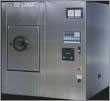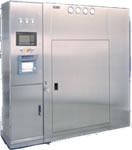Pharmaceutical Sterilizers
Sterilizers are special equipments used to make a product free from live bacteria or other microorganisms. The sterilizer process is used to kill all microbes. The industries such as pharmaceuticals and health care have become more concerned about safety issues and thus sterilizers become an essential component for controlling microbial contamination. Sterilization can be achieved through application of heat, chemicals, irradiation, or filtration.
Sterilization Process
Sterilization process varies from hospital to hospital. Sterilization process is used for cleaning and sterilizing surgical instruments. Dirty instruments come from operating rooms and other areas throughout the hospital to the decontamination area. Instruments are cleaned manually or mechanically.
- In the sterilization process, Instruments are inserted into a tunnel-like or single-chamber unit washing machine.
- The multi-step washing and rinsing process takes 16 or more minutes. Detergent is introduced in the second and third steps, in which the instruments are washed with a small amount of the detergent diluted into several gallons of hot water. This is the stage in which hydraulic fluid was introduced.
- As part of the cleaning process, a lubricant is applied to the clean instruments to prevent rust and ensure the instruments do not lock up during use.
- Instruments are removed by hand from the washing machine in the next room and manually sorted on tables into bundled sets prior to sterilization.
- Instruments are then placed into another machine for sterilization. In the 50-minute sterilization process, instruments are conditioned and sterilized in very high-temperature steam to destroy any possible organisms.
- Instruments are then sent to the operating rooms or other areas throughout the hospital.
There are several kinds of sterilization equipment using different technology and processes, according to the application.
- Steam Sterilizer
- Dry Heat Sterilizer
- ETO Sterilizer
- Sterilizing Tunnel
- CIP System
- SIP System
 Steam Sterilizer
Steam Sterilizer
Steam sterilizers provide a cost-effective solution to sterilize medical waste, infectious waste and other material. Steam Sterilizer Equipment not only helps to eliminate the problem of environmental pollution by doing away with methods like incineration but also helps to minimize and eliminate the expense of disposing off untreated medical waste. This sterilizing equipment sterilizes the waste by exposing it to steam under high pressure, thereby making it free of any contaminants. Manufacturers can design customized sterilizers to suit the needs of individual clients and the waste treating capacity varies depending on the size of the plant.
Sterilizer Equipment not only helps to eliminate the problem of environmental pollution by doing away with methods like incineration but also helps to minimize and eliminate the expense of disposing off untreated medical waste. This sterilizing equipment sterilizes the waste by exposing it to steam under high pressure, thereby making it free of any contaminants. Manufacturers can design customized sterilizers to suit the needs of individual clients and the waste treating capacity varies depending on the size of the plant.
Steam sterilizer is mainly used in Pharmaceutical, Chemical, Food & Beverages and Medical and other Waste Processing Centers. Steam Sterilization is a widely-used method for heat sterilization is the autoclave. Autoclaves commonly use steam heated to 121°C (250°F), at 103 kPa (15 psi) above atmospheric pressure. Proper autoclave treatment will inactivate all fungi, bacteria, viruses and also bacterial spores, which can be quite resistant. It will not necessarily eliminate all proteinaceous infectious particles (prions).
 Dry Heat Sterilizer
Dry Heat Sterilizer
- Dry heat can be used to sterilize items, but as the heat takes much longer to be transferred to the organism, both the
 time and the temperature must usually be increased, unless forced ventilation of the hot air is used.
time and the temperature must usually be increased, unless forced ventilation of the hot air is used. - The standard setting for a hot air oven is at least two hours at 160°C (320°F). A rapid method heats air to 190°C (374°F) for 6 minutes for unwrapped objects and 12 minutes for wrapped objects [1] [2].
- Dry heat has the advantage that it can be used on powders and other heat-stable items that are adversely affected by steam.
| Pharmaceutical Machinery: Applications | Pharmaceutical Machinery: Standards | Pharmaceutical Machinery: Indian Market |
| Pharmaceutical Machinery: Global Market | Pharmaceutical Machinery: Technology | Sitemap | Contact |